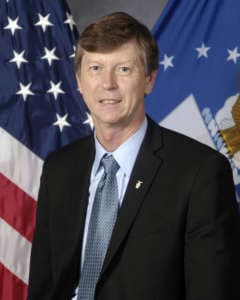

The Defense Department will consolidate the 28 agencies of the fourth estate's networks into just two. Currently, they serve on 34 different networks.
Best listening experience is on Chrome, Firefox or Safari. Subscribe to Federal Drive’s daily audio interviews on Apple Podcasts or PodcastOne.
As part of a larger effort to reform IT services in the Pentagon, the Defense Department is consolidating the myriad of networks owned by its fourth estate as a model for the department and military services.
The fourth estate — 28 DoD agencies that do not belong to military services — currently operates on 34 different networks. Officials said that makes DoD more vulnerable to cyber attacks and makes operating on the networks confusing for defense employees.

Rory Kinney, DoD’s acting deputy chief information officer for information enterprise, said the department is trying to shave the number of networks in the fourth estate to just one non-classified network and one secret network.
“We are starting with the fourth estate,” Kinney said Tuesday during the AFCEA Air Force IT Day in McClean, Virginia. “The intent is to drive the fourth estate to a standardized solution set as a representative of the rest of the environment. The intent is to get it right in the fourth estate before we go and start monkeying around with any of the military departments. We want to get it right here first.”
Kinney said the standardization includes networking, licensing, computing and support.
The networks for each agency “are all in various states,” Kinney said. “Some are very well built. Some have real problems. As a matter of fact, there’s one of them that if you have a problem and you call up the help desk line, only about 25 percent of the time is the telephone actually answered and the problem resolved.”
Kinney said DoD thinks it can solve that by hiring a single commercial service provider to run a consolidated help desk.
DoD is still in the midst of awarding its JEDI contract for cloud services, but it had not sorted out publicly how JEDI would be incorporated into other data storage models the Pentagon uses, like milCloud and traditional data centers.
Kinney cleared some of that up. DoD is currently setting up the program office for JEDI to make sure its employees get the capability they need from the cloud.The challenge comes with legacy systems and sensitive information that can’t be stored on cloud models procured under JEDI.
DoD currently has about 2,500 data centers.

“Our intent is to migrate as much as we can to a cloud environment and then regionalize those data centers,” Kinney said. “Maybe we only have 50 regional data centers across the department to support those folks that need to have a data center, a lot of legacy stuff.”
The next level up is fit-for-purpose clouds — or clouds that have been individually contracted based on mission purposes or return on investment. Kinney said they may allow those clouds to stay, or the Pentagon may eventually push them toward a general-purpose cloud.
DoD is currently moving the fourth estate to milCloud 2.0, the commercially-operated cloud service hosted inside the Defense Information Systems Agency’s data centers.
Finally, there is JEDI, which Kinney said will be multiple general-purpose clouds.
“Not everything is going to JEDI, not everything will stay where it’s at today and over time we will migrate to this new environment,” Kinney said.
In the meantime, the Joint Regional Security Stacks the department has been building to secure its networks and data are being built once again after the department implemented an operational pause in their deployment.The department took a break in implementing JRSS earlier this year so it could train employees and improve processes and hardware. That translated into better deliveries, Kinney said.
The program is now back on track and is about 30 percent finished, Kinney said.
“The big push is really in the Pacific,” Kinney said. “We spent a lot of time working the continental United States and Europe.”
Copyright © 2024 Federal News Network. All rights reserved. This website is not intended for users located within the European Economic Area.
Scott Maucione is a defense reporter for Federal News Network and reports on human capital, workforce and the Defense Department at-large.
Follow @smaucioneWFED
